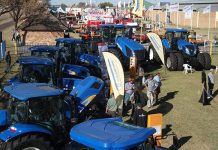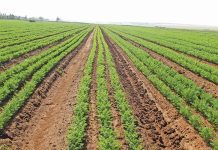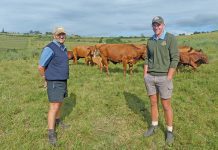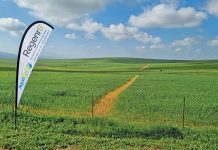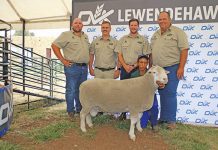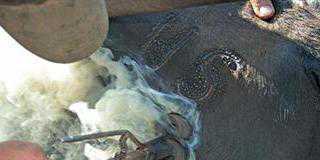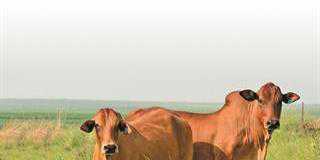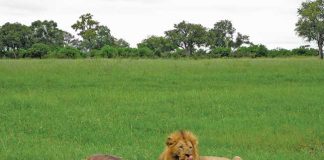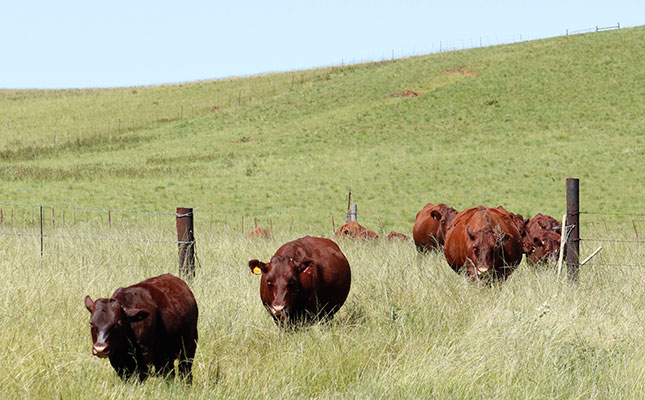
Photo: Wayne Southwood
John Viedge of the Lehana’s Pass Sussex Stud run his animals on the farm Highfield, 10km south of Maclear in the Eastern Cape. The property consists of 2 200ha of very hilly terrain, at an altitude of 1 500m; average rainfall is 700mm with the occasional snowfall.
Viedge is the second generation of the family on the farm. His father, Robert, started farming here in 1931, and launched a Sussex enterprise when he bought four Sussex heifers from Bruce Evans of the Shackleton Stud in Viljoenskroon in 1962.
Viedge joined the family business in 1964 after having studied at Cedara Agricultural College. The family was intially predominantly sheep farmers, running a flock of about
2 000 ewes. However, stock theft on their farm, which borders the former Transkei,
escalated to such an extent in the late 1990s that they were forced to sell all their sheep.
Viedge then bought Sussex cows from Robin Greene of The Start Stud in Karkloof
and from the Huntersvlei Stud in Viljoenskroon.
“We’ve tried farming here with some other breeds, but I can’t see any benefit of crossbreeding,” says Viedge.
“The Sussex breed works for us and that’s why we’ll stick with them.” According to him, Sussex cows make excellent mothers. They are non-selective grazers that forage in all types of terrain, can handle the harsh Eastern Cape winters well, and are resistant to tick-borne diseases.
Grazing
Viedge describes his veld as ‘super sourveld’. It can be tricky to manage and must be kept
fairly short in summer. If it grows too tall, it becomes moribund and unpalatable. He burns half of the farm every year, which helps keep the grass palatable.
The Lehana’s Pass herd comprises 60 stud and 450 commercial Sussex cows.
The calving season runs from the beginning of July until the end of October. During this time, cows are kept close to the farmhouse and have access to maize stover, hay and a protein lick.
Some 50ha of Eragrostis and Sericea lespedeza (‘poor man’s lucerne’) is cut and baled for
winter feeding.
The farm also has 70ha planted to maize, which are rented out, but Viedge can use the stover to graze his animals in winter. In early spring, the cows are given an energy lick with some extra molasses if necessary.
Breeding
Heifers calve for the first time at three years, and those that fail to conceive are culled. Cows that do not produce a calf are also culled; otherwise they are kept until they are 10 years old before being sold.
The breeding season lasts for four months; bulls are put in with the cows at the beginning of October until the end of January.
Young bulls service 25 cows at a time, and older bulls up to 35. When Viedge buys a bull, he looks for a shorter-legged, stocky male with a good hindquarter. He must also be deep-bodied.
The stud and commercial cows receive exactly the same treatment, except during
the breeding season, when they are run separately.
For breeding, Viedge selects a smaller-framed cow weighing between 500kg and 550kg,
whereas breeders in the Free State usually breed Sussex cows weighing 600kg to 650kg
each.
Smaller-framed cows are more suited to the farm’s hilly terrain and harsh winters. The herd inter-calving period is 410 days and the calves average between 35kg and 40kg at birth.
The average weaning weight is about 220kg at seven months. Of the 30 stud bulls born every year, only the top 15 will be selected to be sold as stud bulls.
The others are slaughtered. Viedge markets his bulls at a local, annual, multi-breed
sale with three other breeders.
Collectively, they sell 45 bulls, most of them going to commercial breeders and a few to stud breeders.
They are kept on veld up to three months beforehand, after which they are fed to get
them into sale condition. Before the sale, they are all tested for vibriosis and trichomoniasis.
The best of the young, two year old bulls are used in the stud and on the commercial heifers.
“I believe it’s better to sell a proven, three-year-old bull to clients rather than a two-year-old youngster that might not be up to standard,” says Viedge.
When he considers selection and replacement heifers and the traits he wants to improve, he focuses on the udder in particular.
Coats are an advantage in extreme winter. Viedge has many clients in Barkly East,
and the coats are important in this cold, mountainous area. At the same time, the cattle
must be able to shed the coat fast when summer arrives.
He is also considering acquiring polled genetics.
Animal health
Viedge doses all animals for liver fluke and inoculates for black quarter, contagious abortion and lumpy skin disease once a year.
He has had a number of cases where lumpy skin disease affected the animals’ lungs.
“There are just a few lumps visible on the skin, but when animals die, the post-mortem
examination shows the lungs are riddled with tumours,” he says.
Calves are dosed twice for internal parasites and injected with Multimin (a supplemental source of zinc, manganese, selenium and copper) at two months and then again at weaning.
In the early 1980s, the Transkei cattle herd was decimated by African redwater disease. In later years, this area suffered an outbreak of Asiatic redwater, and Viedge lost 18 cows in one day to the disease.
“The cattle died so fast that if I didn’t treat the sick ones immediately, they’d be dead by
morning. Once an animal started shivering, you could forget about saving it,” he recalls.
The situation became so serious that stockmen carried sachets of Berenil with them. They mixed it on site and injected all animals that looked even slightly sick, together with a dose of Terramycin.
Viedge used live blood vaccines from Onderstepoort with great success, but nevertheless battled for years with the disease while the cows built up immunity to it.
“The solution is to have some ticks on the cattle at all times,” he says.
Calves that are four months old receive a preventative dose of 2ml of Berenil, usually at
the beginning of December. Viedge says that if he does not do this, many calves will become infected with Asiatic redwater by six months of age.
Viedge has long used a plunge dip to control external parasites, dipping early in December until the beginning of May. When the region experiences mild winters, he and his team dip
the animals in June as well.
He admits that he is concerned the ticks are becoming resistant to the dips. For this reason, he has decided to start experimenting with pour-on and injectable remedies.
Phone John Viedge on 045 932 1931 or 073 798 2016, or email him at
[email protected].

